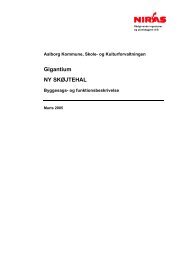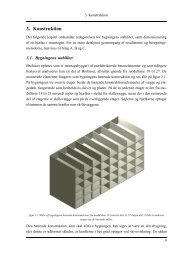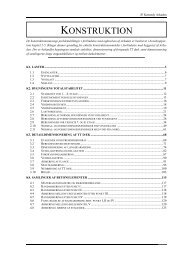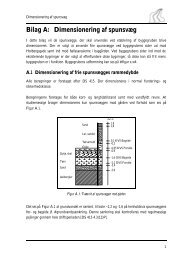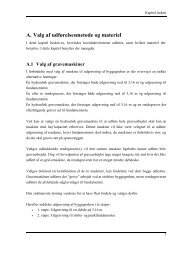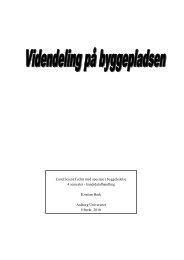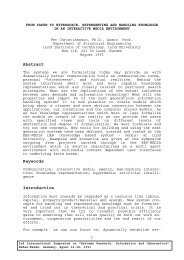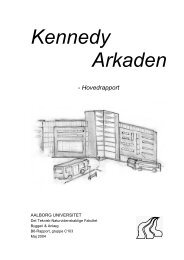building smart - It.civil.aau.dk - Aalborg Universitet
building smart - It.civil.aau.dk - Aalborg Universitet
building smart - It.civil.aau.dk - Aalborg Universitet
You also want an ePaper? Increase the reach of your titles
YUMPU automatically turns print PDFs into web optimized ePapers that Google loves.
Udviklingstendenser indenfor dendigitale byggeproces.Building Smart Buildings bSB.The AAU position.Det Digitale Byggeri. Baggrund og muligheder.Livslang Læring.<strong>Aalborg</strong> <strong>Universitet</strong>.SmartHouse Workshop 3.1.2007, <strong>Aalborg</strong>Per ChristianssonKjeld SvidtPer Christiansson<strong>Aalborg</strong> University24.8.2007WS SmartHouse 3.1.2008, <strong>Aalborg</strong>Building Informatics, <strong>Aalborg</strong> University1/20
A Building Smart Buildings, bSB, platform. 1/2The '<strong>building</strong> Smart Buildings', bSB, platform will act as a vehicle forcontinuously generating and capturing creative ideas and inventions on newproducts and services, and new business models within the bSB domain, withsupport for subsequent design, development, evaluations and high-techproducts and business promotion (demonstration, test installations, training,feed-back capture). The platform will provide a living environment andlaboratory for end users, companies in particular SME´s, and universityresearch groups with possible inclusion of real <strong>smart</strong> <strong>building</strong>s and parts of<strong>smart</strong> cities.PC March 3 2007WS SmartHouse 3.1.2008, <strong>Aalborg</strong>Building Informatics, <strong>Aalborg</strong> University2/20
A Building Smart Buildings, bSB, platform. 2/2- Innovation environment- Demonstration environment and experimentarium- Platform for meetings between end-user, customers,producers, and R&D meetings- The Platform is by nature both VIRTUAL and PHYSICALInteracting with:- Basic Research (models, theories, predictions, deep understanding..)- Strategic and applied research (platforms, methods, tools...)- Innovation (Labs, living labs, platforms, meetings, ...)- Product developmentWS SmartHouse 3.1.2008, <strong>Aalborg</strong>Building Informatics, <strong>Aalborg</strong> University3/20
Helsinki Institute for Information TechnologyMartti MäntyläWS SmartHouse 3.1.2008, <strong>Aalborg</strong>Building Informatics, <strong>Aalborg</strong> University4/20
WS SmartHouse 3.1.2008, <strong>Aalborg</strong>Building Informatics, <strong>Aalborg</strong> University5/20
Project focus domainsSmart Building concept focus domains (platform- project balance)• End-user needs capture and innovation• End-user driven configuration of <strong>smart</strong> <strong>building</strong>s• Services in intelligent cities and <strong>building</strong>s• Visualisation and simulation of <strong>building</strong> system solutions• Smart <strong>building</strong> components and technical systems• Smart adaptable and context sensitive spaces• …..The platform will support the both the <strong>building</strong> <strong>smart</strong> process(customer driven design, general component design etc.),including the <strong>smart</strong> global business model (the whole chain ofcustomers and their value and cost attributes) as well as the<strong>smart</strong> <strong>building</strong>s/cities (the <strong>smart</strong> end products).WS SmartHouse 3.1.2008, <strong>Aalborg</strong>Building Informatics, <strong>Aalborg</strong> University6/20
Services area supportThe bSB platform could focus on different societal domainssuch as, living environment, working environment, healthcareand safety, social meeting environment and <strong>building</strong>/city O&Msupported by Information and Communication Technologies,ICT. The following services area can be supported by theplatform• Services for Comfort• Services for Safety and Security• Services for Sustainable Performance• Services for Human/Building/City interaction• Services for Health and Well-being• Services for ……WS SmartHouse 3.1.2008, <strong>Aalborg</strong>Building Informatics, <strong>Aalborg</strong> University7/20
The Building/City functional system viewThe virtual <strong>building</strong> can be used forsimulation and design of newservices and user environments,interactive documentation of theready <strong>building</strong> to support differentservices such as O&M activities,location of resources and persons inthe <strong>building</strong>, andThe physical and virtual <strong>building</strong>s ismore or less functionally integratedwith other <strong>building</strong>s, city areas, andoptional global 'neighbourhoods'.WS SmartHouse 3.1.2008, <strong>Aalborg</strong>Building Informatics, <strong>Aalborg</strong> University8/20
Needs - Services - ResourcesWS SmartHouse 3.1.2008, <strong>Aalborg</strong>Building Informatics, <strong>Aalborg</strong> University9/20
Customer - service - infrastructureRelations between main actors - customers, service providers andinfrastructure providers - in the digital city.WS SmartHouse 3.1.2008, <strong>Aalborg</strong>Building Informatics, <strong>Aalborg</strong> University10/20
Services area supportIn order to develop the services mentioned above development the platformwill support development of a business models and number of importanttechnologies. For example:• Development of cheap and reliable multiparameter sensors• Development of new strategies for technical systems in <strong>building</strong>s• Development of a personal self-learning database covering indoorclimate, communication etc. needs and preferences as well asspecification and usage descriptions of supporting ICT systems.• Model based control of technical <strong>building</strong> services and energysystems• New context sensitive communication systems and userenvironments for human/<strong>building</strong> interaction• Ontologies management and access to support use, design andimplementation of new services. Development of Smart Buildingsmetrics and standards contribution.• Smart Building needs/requirements specification system to beused by end-users, clients, service and <strong>building</strong> componentproviders, etc.WS SmartHouse 3.1.2008, <strong>Aalborg</strong>Building Informatics, <strong>Aalborg</strong> University11/20
Intelligent Building definitionIn 2000 the author made the following definition:"Intelligent <strong>building</strong>s are <strong>building</strong>s that through their physical design and ITinstallations are responsive, flexible and adaptive to changing needs from itsusers and the organisations that inhabit the <strong>building</strong> during its life time. The<strong>building</strong> will supply services for its inhabitants, its administration andoperation & maintenance. The intelligent <strong>building</strong> will accomplish transparent'intelligent' behaviour, have state memory, support human and installationsystems communication, and be equipped with sensors and actuators."Some important characteristics in future Intelligent Buildings can be• be flexible and responsive to different usage and environmentalcontexts• be able to change state (with long and short term memory)• contain tenant, O&M, and administration service systems• support human communication• accomplish 'intelligent' behaviour and transparent intelligence• Integrate different IB systems to form complex systemsWS SmartHouse 3.1.2008, <strong>Aalborg</strong>Building Informatics, <strong>Aalborg</strong> University12/20
End user needs and requirements captureThere is a great need today to secure development with belowspecified areas to secure <strong>smart</strong> <strong>building</strong>s to meet future needs fromend users and technology providers• Systematic description of existing and futureapplication/business services needs in terms of applicationdomain, functionality, involved actors, organisation, and usecontexts.• Systematic description of existing and future available <strong>smart</strong><strong>building</strong>/<strong>smart</strong> city services in terms of application domain,functionality, and use context.• Systematic description of existing and future availableresources that can support provided services.This is a complex design endeavour that well could besupported by a platform as suggested below, bSB - <strong>building</strong>Smart Buildings platform.WS SmartHouse 3.1.2008, <strong>Aalborg</strong>Building Informatics, <strong>Aalborg</strong> University13/20
Virtual Innovation in Construction - VIC projectBrugerinvolvering i ByggeproecessenThe project goal is to create an ICTsupported methodology VIC - VirtualInnovation in Construction, to involve<strong>building</strong> end user in a creativeinnovation process together with<strong>building</strong> designers, to capture andformulate end-user needs andrequirements on <strong>building</strong>s and theirfunctionality.An open dynamic innovation spaceVIC SPACE is created with accessfrom WWW.Rambøll, Arkitema, AAUWS SmartHouse 3.1.2008, <strong>Aalborg</strong>Building Informatics, <strong>Aalborg</strong> University14/20
More projects:"New ways of working and collaboration "Increase the possibility of successful implementation and adoption ofnew ICT tools in the construction sector across the supply chainthrough increasing the knowledge of how to execute suitabledevelopment and innovation diffusion/implementation schemes. Thefocus will be on context dependent (economic, social, political andpractice specific dependencies) mapping of organisations (at variouslevels) and ICT- demands and how they interact.Participants: Lund University (Sweden), Selvaag Blue Think AS(Norway), NTNU (Norge), AAU (Denmark)Nordic Innovation Center, NICe.Project time January 2008 - December 2008.Kjeld Svidt will mention other relevant results/projects.- DIVERCITY - Distributed Virtual Workspace for enhancingCommunication within the Construction Industry (EU)- IT på Byggepladsen- Det Digitale Bygger, DDB- Modelserver in praksis- Linking Virtual Models with PhysicalObjects in Construction- IT in Collaborative Design (semantic web support). PhD report.WS SmartHouse 3.1.2008, <strong>Aalborg</strong>Building Informatics, <strong>Aalborg</strong> University15/20
Virtual spacesA Virtual Space (VS) may be defined as a mixed reality environment optionallyinvolving many physical spaces and many virtual spaces.A VS may be set-up within one <strong>building</strong> or many <strong>building</strong>s placed in the localcommunity or on the other side of the world.A VS do not have to be stationary but can e.g. follow a person defined as theimmediate surrounding of that person. In this latter case wireless connection to thespace is a necessity and maybe a complication in interaction with stationary spaces.A virtual space may provide service to support many kinds of activities.We may define virtual workspaces supporting collaboration, home health care spacewith access to distant doctors, different communities of interest or practice, virtualcity space for service discovery and access etc.The impact on social behaviour, economics, and personal values due to virtual spacesintroduction should continuously be monitored and taken into account.WS SmartHouse 3.1.2008, <strong>Aalborg</strong>Building Informatics, <strong>Aalborg</strong> University16/20
The Mixed Reality"Simplified representation of a RV Continuum." (Milgram et.al., 1994)WS SmartHouse 3.1.2008, <strong>Aalborg</strong>Building Informatics, <strong>Aalborg</strong> University17/20
uilding Smart Buildings, bSB, platformA bSB, <strong>building</strong> Smart Buildings, platform will actively contribute to the <strong>building</strong> of <strong>smart</strong><strong>building</strong>s/cities by providing mechanisms for idea generation and product/services developmentbeyond inventions in isolation.WS SmartHouse 3.1.2008, <strong>Aalborg</strong>Building Informatics, <strong>Aalborg</strong> University18/20
ResultsImportant results of the “SmartHouse” project are:• Efficient platform tools and methodologies.• Raised competences among partners. General public competencelift.• Improvement of holistic design of Smart Buildings/Cities.• Generic <strong>smart</strong> <strong>building</strong> and <strong>smart</strong> city ontologies.• Establish foundation for development of new and improved end-userservices and products, based on Smart House concept beyondinvention in isolation.• Motivations for (forming of) companies providing new end-user andinfrastructure services.• Better and new end products fulfilling end-user needs andrequirements.• New global business models.WS SmartHouse 3.1.2008, <strong>Aalborg</strong>Building Informatics, <strong>Aalborg</strong> University19/20
END+2 extrashttp://it.<strong>civil</strong>.<strong>aau</strong>.<strong>dk</strong>WS SmartHouse 3.1.2008, <strong>Aalborg</strong>Building Informatics, <strong>Aalborg</strong> University20/20
Helsinki Institute for Information TechnologyMartti Mäntylä (for Discussion)WS SmartHouse 3.1.2008, <strong>Aalborg</strong>Building Informatics, <strong>Aalborg</strong> University21/20
Services OntologiesAn ontology is an explicit formalspecification of how to represent theobjects, concepts and other entitiesthat are assumed to exist in somearea of interest and the relationshipsthat hold among them.A service request may generatealternative support system actionsdepending on context and/or otherparallel services requests. Worse caseis that a critical service will invoketemporary close down of otherservices.From Christiansson P. (2007) "ICT EnhancedBuildings Potentials", Proceedings 24th CIB W78Conference "Bringing ICT knowledge to work".June 26 - 29 2007, Maribor, Slovenia. ISBN 978-961-248-033-2. (pp. 373-378).http://it.<strong>civil</strong>.<strong>aau</strong>.<strong>dk</strong>/it/reports/2007_06_w78_maribor_pc2.pdfWS SmartHouse 3.1.2008, <strong>Aalborg</strong>Building Informatics, <strong>Aalborg</strong> University22/20



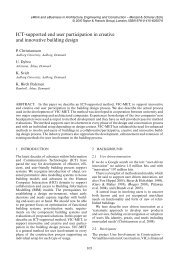
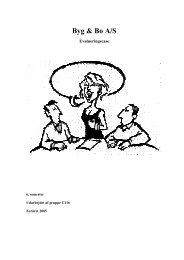
![[abs ID] PAPER TITLE - IT in Civil Engineering. Aalborg University](https://img.yumpu.com/51222254/1/184x260/abs-id-paper-title-it-in-civil-engineering-aalborg-university.jpg?quality=85)

